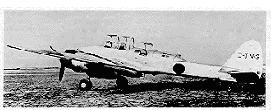![]() The Pacific War Online Encyclopedia
The Pacific War Online Encyclopedia
|
| Previous: J1 Class, Japanese Submarines | Table of Contents | Next: J2F Duck, U.S. Reconnaissance Seaplane |

U.S. Navy. From Francillon (1979)
Nakajima J1N1-S Gekko ("Moonlight") “Irving”
| Crew | 2 |
| Dimensions | 55’8” by 40’0”
by
15’0” 16.98m by 12.77m by 4.562m |
| Wing area | 431
square feet 40 square meters |
| Weights | 10.697-18,043 lbs 4840-8184 kg |
| Maximum speed | 315 mph at 15,000 feet 583 km/h at 5840 meters |
| Cruising speed | 160 mph at 12,000 feet 257 km/h at 3700 meters |
| Climb rate | 33 feet per second 10.1 meters per second |
| Service ceiling | 30,610 feet 9320 meters |
| Power plant | Two 1130 hp (843 kW) Nakajima NK1F Sakae (one Sakae 21 and one Sakae 22) fourteen-cylinder air-cooled radial engines driving opposite rotating three-blade constant-speed metal propellers. |
| Armament | Two fuselage-mounted
upward-firing 20 mm
Type
99 cannon Two 20 mm Type 99 downward-firing cannon |
| External stores |
2 330 liter (72.6 gallon) drop
tanks 2 551 lb (250kg) bombs (as kamikaze) |
| Range | 1585 miles (2550 km) normal 2330 miles (3750 km) overloaded |
| Fuel capacity |
374 gallons 1700 liters |
| Production | A total of 479 J1Ns
were built by Nakajima Hikoki K.K. at Koizumi
as follows: 2 J1N1 prototypes (spring 1941) 7 J1N1-C prototypes (1941-42) 54 J1N1-C and J1N1-R (1942-7 to 1943-3) 183 J1N1-C KAI and J1N1-S (1943-4 to 1944-3) 233 J1N1-S and J1N1-Sa (1944-4 to 1944-12) |
| Variants |
The –C was a
reconnaissance aircraft with a crew of 3 and armed with one rear-firing
flexible 13 mm Type 2
machine
gun. It was later redesignated the -R. The -C KAI were -Cs converted to night fighters. They otherwise
resembled the -S. The -Sa
carried armament of two fuselage-mounted
upward-firing 20 mm
Type
99 cannon and either was fitted with airborne radar or a forward-firing 20mm Type 99
cannon. Airborne radar was also retrofitted to some
-S units. |
"Irving" was originally designed as
a long-range escort
fighter, based on a 1938 specification for a fighter capable of
escorting Japanese bombers on
raids against airfields deep in Chinese territory. The design was
inspired by the French Potez 63, with heavy armament and the
maneuverability to engage single-seat fighters. The design team, led by
Nakamura Katsuji, chose to power the aircraft with matched handed
engines to elimnate engine torque, and armed the prototype with both
forward-firing cannon and machine guns and a pair of remote-controlled
dorsal barbettes. The first prototype flew in May 1941 but had serious
bugs, and a second prototype was equipped with both trailing flaps and
leading edge slots. Both prototypes were heavy and had excessively
complex hydraulic systems. Though very maneuverable for a two-engine
fighter, it could not match the A6M
"Zero" in any performance category but range.
As a result, the Navy ordered the airframes
already on the assembly line to be completed as reconnaissance aircraft
with the dorsal barbettes removed, the fuel capacity reduced, and the
engines replaced with unhanded Sakae 21s. Provisions for drop tanks
were made to restore some of the range. The reconnaissance design was
designated as the J1N1-C (and later redesignated as the J1N1-R.)
An imaginative
commander found in the spring of 1943 that "Irving" could be rearmed
with oblique cannon as a night
fighter, and most of the production was converted to night fighters
on
this
plan under the designation J1N1-C KAI. Additional aircraft built from
scratch as night fighters were designated as the J1N1-S. Unfortunately
for the Japanese, this robust night
fighter lacked the speed to make more than a single pass at the fast,
high-flying B-29s,
though it proved effective against patrolling B-24s.
Most of the surviving "Irvings" were expended as
kamikazes in 1945.
References
The Pacific War Online Encyclopedia © 2007, 2009 by Kent G. Budge. Index